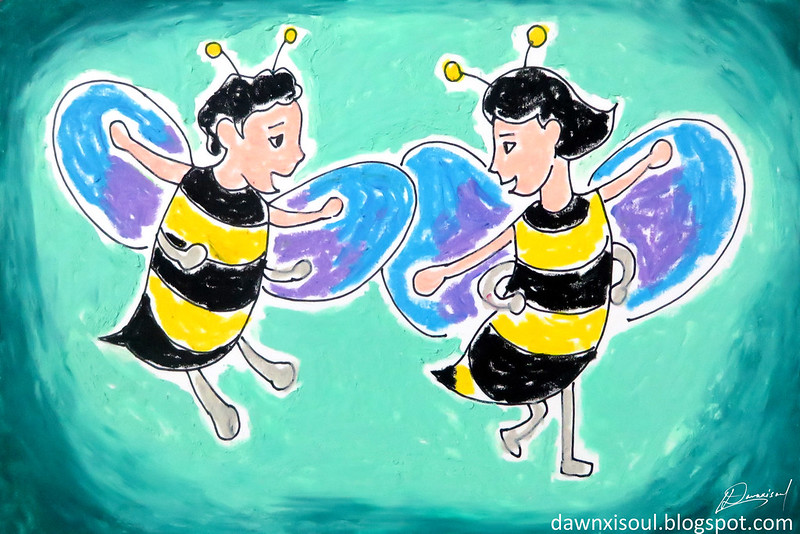
The language of bees is the bees’ knees, ya know?
Bees are amazing creatures, coming in more than 25,000 species, many of which don’t look much like the stereotypical image of a fat, furry, brightly striped, bundle of honey-making buzz. This stands to reason when you compare that cool 25K to the mere 10,000 kinds of seemingly ubiquitous bird or the paltry 6400 species of mammal.
In addition to a panoply of forms, bees have developed different methods of communication, including the honey bee, whose three-part communication system of touch, pheromones, and booty-dancing can appropriately be called a language.
Humans—who have been keeping bees for nearly 10000 years—have likewise created language to describe their bonhomous friends, and the craft of keeping them healthy and harvesting their honey.
But here a linguistic mystery lurks. We call the places where bees are kept apiaries, and the beekeepers who keep them apiarists, thanks to the Latin apis (bee)…but we have no idea where that word came from.
Linguists have their theories. The most popular posits a path from the Old English imbe, and the German Imme (bee; swarm of bees), but no evidence to support this logical idea has been found, and the word remains unrelated to anything so far discovered in other Indo-European languages
My only guess, sadly disproven by phonetics and pronunciation, was some connection to the ancient Egyptian deity Apis, though I had no idea how to reconcile our tiny, winged friends with a sacred bull worshiped by Ancient Egyptians for its great heart and physical strength.
Now, as I mentioned before, the tiny-brained honey bee famously possesses a productive language expressed through dance. When an exploring bee discovers a food source, they return to their hive and—having shared some or all of their stomach contents in a process called "unloading"—begin one of two dances to share their discovery.
If the destination is relatively close, the bees perform a "round dance," dancing in circles, changing direction occasionally. This dance basically means: I’ve left a scent out there, now go find it!
If the food is further away, the bees perform their famous "waggle dance," where in addition to dancing and buzzing their wings, the returning bees also waggle their body. Each piece of this dance conveys information: the duration of the waggling represents distance, and the angle of the waggling run represents the direction relative the sun’s angle from the hive.
In either case, the bees following the dancer decode his dance and convey the directions to the rest of the hive so they can all share in the buzzy bounty.
But that’s not even the most fascinating part of these bees’ actions. Because this communication isn’t only used to find and share food sources, but also to share new and better locations for the entire hive. Which means these bees communicate and make colony-wide collective decisions…and generally do so better than we big-brained, supposedly-superior humans.
Consider it: a hive sends out multiple scouts who return with different possible places to move the hive. And then, using only their primitive means of communication—each bee able to communicate with just the tiniest fraction of the rest—debate ensues until, without fail, a winner is determined and the entire hive picks up and moves.
Not only is this a unanimous decision to move, but the coordination of that move is also managed through this limited, collective means of communication. No small feat when you consider a hive can contain up to 60,000 individuals!
Compare that to the extensive rules, procedures, polling, and other apparatus humans develop into multi-layered structures that rarely come to agreement, much less consensus.
In his book Honeybee Democracy, Thomas Seeley lays out, in readable way, what his more than 40 years of research has revealed about honeybee communication, including his most recent investigations into the democratic process of hive movement, and how with limited intelligence and information, each bee in a hive acts similarly to a neuron in the brain.
In addition to being an incredible read for anyone who wants to be amazed by nature, Seeley determines five characteristics underlying the honey bee collective’s "systemic intelligence," in which the group is far smarter than its smartest individual. This is a valuable model we squabbling humans could learn from as the human hive continually fractures into groups that are often hardly as smart—and even less effective—than their least intelligent and most ardent—members.
For more on bees and language, including whether honey bee is one word or two, a proposition involving Sean Bean and Mila Kunis, or to listen or re-listen to this, or any other Katexic WORD segment, head on over to katexic.com/kuac.
[Creative Commons licensed image by Dawnxisoul393-Illustrations]




Leave a Reply